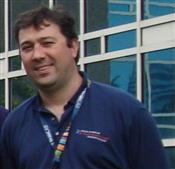Program Information
MLC Distance Travelled as a Predictor for Motor Failure
S Stathakis1*, D Defoor1 , P Linden1 , N Kirby1 , P Mavroidis2 , N Papanikolaou1 , (1) UTHSCSA, San Antonio, TX, (2) University of North Carolina, Chapel Hill, NC
Presentations
SU-E-T-545 (Sunday, July 12, 2015) 3:00 PM - 6:00 PM Room: Exhibit Hall
Purpose: To study the frequency of Multi-Leaf Collimator (MLC) leaf failures, investigate methods to predict them and reduce linac downtime.
Methods: A Varian HD120 MLC was used in our study. The hyperterminal MLC errors logged from 06/2012 to 12/2014 were collected. Along with the hyperterminal errors, the MLC motor changes and all other MLC interventions by the linear accelerator engineer were recorded. The MLC dynalog files were also recorded on a daily basis for each treatment and during linac QA. The dynalog files were analyzed to calculate root mean square errors (RMS) and cumulative MLC travel distance per motor. An in-house MatLab code was used to analyze all dynalog files, record RMS errors and calculate the distance each MLC traveled per day.
Results: A total of 269 interventions were recorded over a period of 18 months. Of these, 146 included MLC motor leaf change, 39 T-nut replacements, and 84 MLC cleaning sessions. Leaves close to the middle of each side required the most maintenance. In the A bank, leaves A27 to A40 recorded 73% of all interventions, while the same leaves in the B bank counted for 52% of the interventions. On average, leaves in the middle of the bank had their motors changed approximately every 1500m of travel. Finally, it was found that the number of RMS errors increased prior to an MLC motor change.
Conclusion: An MLC dynalog file analysis software was developed that can be used to log daily MLC usage. Our eighteen-month data analysis showed that there is a correlation between the distance an MLC travels, the RMS and the life of the MLC motor. We plan to use this tool to predict MLC motor failures and with proper and timely intervention, reduce the downtime of the linac during clinical hours.
Contact Email:


